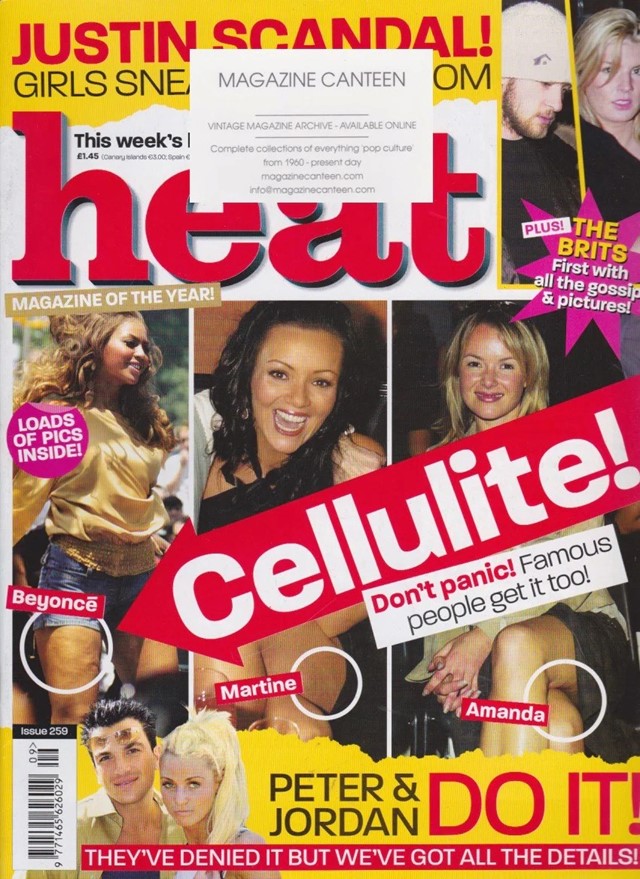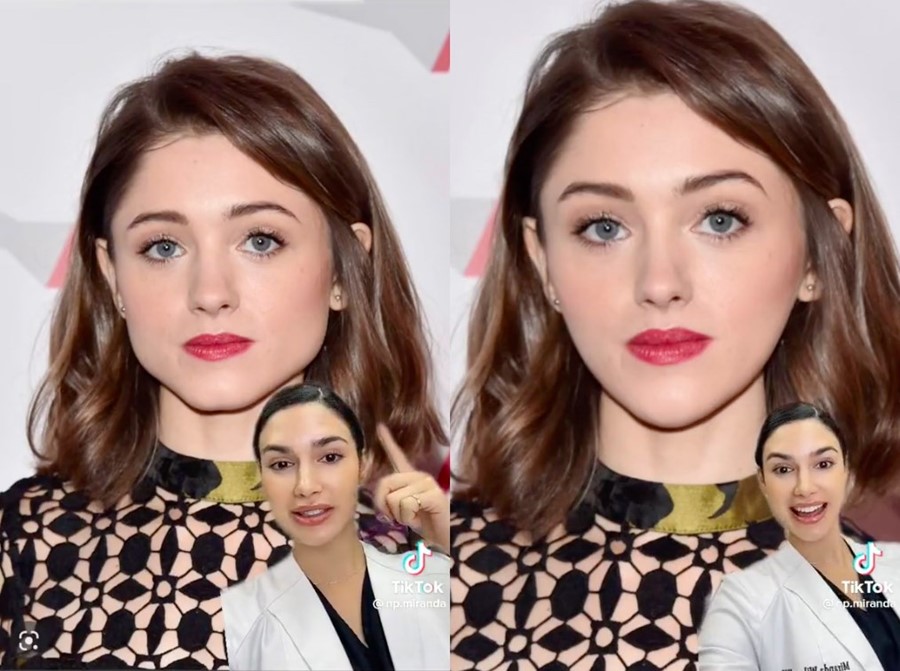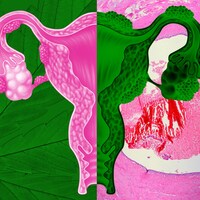Picking apart celebrity faces may seem like harmless entertainment, but we aren’t consuming it consequence-free
My teenage years coincided, rather unfortunately, with the height of Heat magazine. Week after week, I would read about the best celebrity tummies, the worst summer bodies, the top 20 celebrity “flaws” – Uma Thurman’s big hands, Emma Bunton’s large forehead – the cellulite, the sweat patches, the tanning disasters. All of them dissected and analysed in excruciating detail.
Uma Thurman and Emma Bunton may or may not have seen the zoomed in paparazzi pictures of their so-called flaws splashed across the covers, but every young girl and boy with a “large forehead” or “big hands” reading at home certainly felt a lot shittier about themselves. To this day, I can’t look at my cellulite without my brain unhelpfully conjuring up a big red circle around the offending area. And after pouring over issue after issue dedicated to ranking summer bodies, years later I still find myself buying high-waisted bikini bottoms to hide my stomach on the beach.
Heat magazine, thankfully, doesn’t hold the cultural sway it used to – but its toxic culture of scrutinising a celebrity’s every feature can, unfortunately, now be found alive and well on social media. No longer focused on just their natural “flaws”, the new breed of gotcha-content making is dedicated to uncovering and exposing celebrity modifications, both surgical and photoshopped.
With clinical precision, eagle-eyed Instagram and TikTok accounts pick apart celebrity “transformations”, highlighting the straighter noses and teeth, the Facetuned wrinkles and waists, the lifted brows, the plumper lips and bigger boobs. Many of the people behind these accounts are professional plastic surgeons, who use their knowledge and credibility to make claims about what procedures they believe celebrities have undergone. Surgeons like Dr Daniel Barrett and Dr Charles S Lee have racked up millions of followers and views on TikTok from posting about the “plastic surgery secrets” of public figures.
But recently things have taken an even more sinister turn, because now it's not just about what celebrities may have had done – increasingly attentions are turning to what they should have done. Accounts like @goddess.women and @photoshoppe are dedicated to photoshopping celebrities and giving them imagined cosmetic procedures, taking it upon themselves to “improve” the areas they think celebs are lacking in. @virtualplasticsurgeon – promoted by Dr Michael Keyes, a real cosmetic surgeon behind Instagram account @CelebrityPlastics – takes it one step further by listing the simulated treatments. Model Jeanne Cadieu, for example, is given the following procedures: hairline lowering, forehead filler, endoscopic brow lift, temporal implants, cheek augmentation, rhinoplasty, v to y lip lift, and jaw reduction.
The backlash is starting to begin against these types of practices, however. Over the weekend, Miranda Wilson, an aesthetic nurse practitioner with 40K TikTok followers posted a video in which she detailed what types of procedures she would give Stranger Things actress Natalia Dyer. Saying she would start by “treating those masseters” to slim down the face, Wilson goes on to add chin filler, lip filler, Botox and a brow lift – “to help open up her eyes” – to the list. She then ends with a photoshopped image of Dyer to show what the results would look like.
People were, understandably, angered and upset by the video. Twitter user @probablypersian reposted the clip with the caption, “i could never be a celebrity because if someone made a video like this about me i would get violent”. In just three days it has gained over 460K likes and 2000 comments, overwhelmingly negative.
The fact that the new and “improved” photoshopped Dyer looks absolutely ridiculous is besides the point. At a time when we are in a self-esteem crisis, when eating disorder rates are skyrocketing, when half of both men and women experience body dysmorphia, giving unsolicited “improvements” and criticism about someone’s face is gross and degrading. Coming from a person who has the power to influence how people are changing their faces on a daily basis, it’s irresponsible, dangerous and unethical.
This video is so toxic that if TikTok is showing shit like this to children, it's no wonder our youth is suffering from such high rates of suicide and depressionpic.twitter.com/YHXlhpNSQi
— Fifty Shades of Whey (@davenewworld_2) July 25, 2022
Many people also pointed out how these kinds of tactics are often a capitalist ploy to push products or services by playing on people’s insecurities. “One thing they taught young me in advertising (before I left it) is that our job was to destroy self esteem. By targeting someone people hold as extremely beautiful, they are targeting your self esteem more than they are Natalia Dyer,” activist Rafael Shimunov wrote on Twitter in relation to Wilson’s post.
And it seems to be working. Many people in the comments spoke out about how they would have been influenced by videos such as these in more vulnerable stages of their lives. “I have struggled with body image since I can remember, especially things like the shape of my jaw and face,” one commenter wrote. “If I had seen this when I was 15 I would have been trying to figure out which possessions I could sell to get this done on myself.”
Wilson has since removed the video and said she “did not mean to offend anyone”. But she is just a symptom, rather than the cause, of our toxic culture of body shaming. When it comes to celebrities or people in the public eye, often the justification given is that it’s a way to help us non-famous people feel better about ourselves. “Don’t panic! Famous people get it too!” reads the byline for Heat’s cellulite shaming 2004 cover story. This line of reasoning has been passed down to the next generation.
“The internet has so many lies. Some people tell me on the daily that my account boosts their self-esteem because now they know that influencers are not perfect and that they have flaws or insecurities,” the anonymous user behind Exposingallcelebs, an Instagram that chronicles the visual transformations of celebrities, told Dazed Beauty in 2019.

The desire to lift the veil for the sake of transparency and the self-esteem of many is understandable. However, whether the intentions are good or bad, this dissection of people’s bodies, famous or not, is causing us more damage than good. Picking apart celebrity faces may seem like harmless entertainment but we aren’t consuming it harmlessly. It’s toxic, not just for the subjects, but for everyone. “When you start viewing celebrities as a combination of body parts that you are going to be the judge of, the likelihood is that you will end up treating other people in your life and yourself in the same way,” says Viren Swami, professor of social psychology at Cambridge’s Anglia Ruskin University, who specialises in body image and human appearance.
After analysing, feature by feature, a celebrity's face, the next time you look in the mirror chances are you will start studying your own face in the same way, analysing and diagnosing every small perceived flaw and opportunity for improvement. All we are really doing, Swami says, is training ourselves to be hyper-aware of every feature and every “fault,” and this awareness only leads to finding faults in ourselves. “When people view these images, they end up feeling more anxious about their bodies, they have lower self-esteem, and they’re much more likely to be willing to consider cosmetic surgery in the future,” he says.
Faces should be different and interesting. Watching @photoshoppe take celebrities’ faces and edit them down to fit a “perfect” ratio, erasing every unique and distinguishing aspect of them, over and over again is depressing. Seeing plastic surgeons or medical professionals mould faces to produce the same bland look over and over again is bleak. Why should we all just look like one generic, just-add-water-Insta girl? As writer Sarah Manavis commented after viewing Wilson’s TikTok: “Social media has done a lot of terrible things, and many are far worse, but popularising the pervasive idea that beauty means everyone having the exact same face is up there.”




